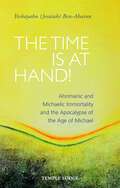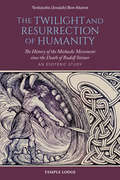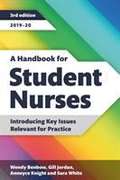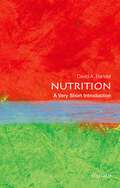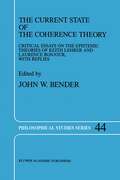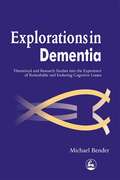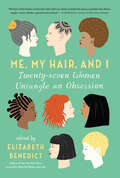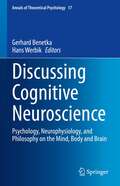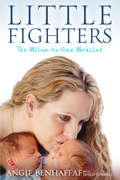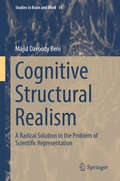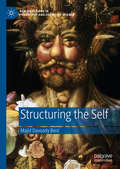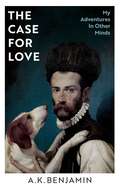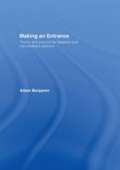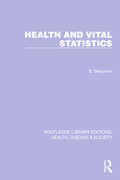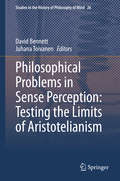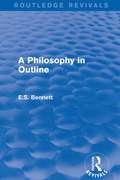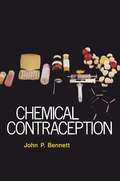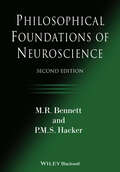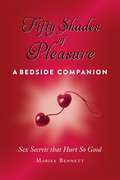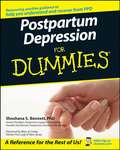- Table View
- List View
The Time is at Hand!: Ahrimanic and Michaelic Immortality and the Apocalypse of the Age of Michael
by Yeshayahu Jesaiah Ben-Aharon'The twenty-first century is the second, middle century of the three centuries of the present age of Michael, and it is the most decisive one. If humanity again misses Michael's goal, it will hardly be possible to recuperate from it, and human evolution will be derailed for a long time. The present age of Michael can therefore rightly be called 'the Apocalypse of the age of Michael'. – Yeshayahu Ben-Aharon In five lively, challenging lectures, Dr Ben-Aharon offers encouraging perspectives on the apocalyptic challenges facing humanity. The key Michaelic task for human beings today, he says, is to comprehend fully the new revelation of the etheric Christ. On the success of this depends humanity's resurrection from the abyss – from the grave of civilization. However, it can still be achieved, and the time is at hand! The author describes the global School of Spiritual Science's contemporary work to create a path to conscious recognition of the Christ and Michael impulses. Offering numerous fresh viewpoints into the trials of our time, The Time is at Hand! is an essential handbook for any serious student of anthroposophy. The talks (from 2017 and 2022) are titled: 'Ahrimanic Immortality, the Matrix and the Technological Singularity'; 'Michaelic Immortality'; 'The Two Apocalyptic Beasts and the Mystery of the Wound; 'Follow This Star'; and 'The Time is at Hand!'
The Twilight and Resurrection of Humanity: The History of the Michaelic Movement since the Death of Rudolf Steiner
by Yeshayahu (Jesaiah) Ben-AharonThis unique work – the fruit of many decades’ research and experience – throws new light on the supersensible history and karma of the Michaelic movement since Rudolf Steiner’s death. It describes that movement’s evolution and transformation in the etheric world during the twentieth century, from the world-changing apocalypse of the 1930s and 40s through to the beginning of its incarnation on Earth at the end of last century. The book also focuses on developments in the practical and social work of building the community of the School of Spiritual Science, which embodies the new Michaelic movement in our time.As Ben-Aharon indicates, the Michaelic movement is searching for creative, courageous and enthusiastic souls to foster a strong community that develops – from one decade to the next – as a living organism. Based on the continuous resurrection of anthroposophy, this community strives to create a fully conscious meeting and communication with the school of Michael and Christ in the etheric world, in a form that is appropriate and demanded by the times. The transcripts of these lectures bring together the author’s experiences with anthroposophy over the last 42 years in the light of present communications from the spiritual world. It is based on contemporary spiritual investigation and individual, lived experience.From the Contents: ‘The Amfortas-Parsifal Duality of Modern Humanity’; ‘The Twilight of Humanity and its Resurrection’; ‘The Universal Language of Michael and the Being of Rudolf Steiner’; ‘The Anthroposophical Movement in the Present’; ‘The Etheric Form is Alive’; ‘The Resurrection of the Etheric Christ in the 21st Century’.
A Handbook For Student Nurses: Introducing Key Issues Relevant For Practice (3rd edition) (PDF)
by Wendy Benbow Gill Jordan Anneyce Knight Sara WhiteA Handbook for Student Nurses provides an introduction to the essential background knowledge that pre-registration nursing students need as a foundation for their training. This third edition reflects the new NMC standards of proficiency for registered nurses and the latest update of the NMC Code. Thoroughly revised and with a completely new chapter on health promotion, the book incorporates the latest developments in nurse education and in the health service.
Nutrition: A Very Short Introduction (Very Short Introductions)
by David BenderNutrition is a topic of wide interest and importance. In spite of growing understanding of the underlying biochemistry, and health campaigns such as 'five-a-day', increasing obesity and reported food allergies and eating disorders, as well as the widely advertised 'supposed' benefits of food supplements mean that a clear explanation of the basic principles of a healthy diet are vital. In this Very Short Introduction, David Bender explains the basic elements of food, the balance between energy intake and exercise, the problems of over- and under-nutrition, and raises the question of safety of nutritional supplements. ABOUT THE SERIES: The Very Short Introductions series from Oxford University Press contains hundreds of titles in almost every subject area. These pocket-sized books are the perfect way to get ahead in a new subject quickly. Our expert authors combine facts, analysis, perspective, new ideas, and enthusiasm to make interesting and challenging topics highly readable.
The Current State of the Coherence Theory: Critical Essays on the Epistemic Theories of Keith Lehrer and Laurence BonJour, with Replies (Philosophical Studies Series #44)
by J. BenderThe subtitle of this book should be read as a qualification as much as an elaboration of the title. If the goal were completeness, then this book would have included essays on the work of other philosophers such as Wilfrid Sellars, Nicholas Rescher, Donald Davidson, Gilbert Harman and Michael Williams. Although it would be incorrect to say that each of these writers has set forth a version of the coherence theory of justification and knowledge, it is clear that their work is directly relevant, and reaction to it could easily fill a companion volume. This book concentrates, however, on the theories of Keith Lehrer and Laurence BonJour, and I doubt that any epistemologist would deny that they are presently the two leading proponents of coherentism. A sure indication of this was the ease with which the papers in this volume were solicited and delivered. The many authors represented here were willing, prepared, and excited to join in the discussion of BonJour's and Lehrer's recent writings. I thank each one personally for agreeing so freely to contribute. All of the essays but two are published for the first time here. Marshall Swain's and Alvin Goldman's papers were originally presented at a symposium on BonJour's The Structure of Empirical Knowledge at the annual meeting of the Central Division of the American Philosophical Association, Chicago, Illinois, in April, 1987.
Explorations in Dementia: Theoretical and Research Studies into the Experience of Remediable and Enduring Cognitive Losses (PDF)
by Michael BenderBased on the findings of in-depth research and on the author's long-standing experience of working with people with dementia, this ground-breaking book provides fresh perspectives and ideas for policy and practice. In the first part of this extensively referenced and up-to-date book, Michael Bender examines the scientific status of the terms 'dementia', 'Alzheimer's' and 'multi-infarct dementias' and concludes that there is little convincing scientific evidence to justify their continued use. He suggests that in order to develop adequate psychological and social models of dementia, a number of perspectives, such as the intrapsychic, the interpersonal and the contextual, need to be developed. Drawing on contemporary theoretical concepts including multiple selves, personal construct theory, intrapsychic survival and the effect of historical and political factors on older people's well being, the author calls for a more positive and constructive approach to improving the lives of people with dementia. He emphasises the importance of the individual's social context; the problems they are facing and their reactions to those problems; their life history and interpersonal relationships and discusses the process of assessment, finally developing techniques that allow the person with dementia to describe their experience, helping to ameliorate cognitive losses. Taking an honest look at what we really know about dementia and how we can learn more, this innovative book will make essential reading for medical and mental health practitioners, researchers and students working in the field.
Me, My Hair, and I: Twenty-seven Women Untangle an Obsession
by Elizabeth BenedictAsk a woman about her hair, and she just might tell you the story of her life. Ask a whole bunch of women about their hair, and you could get a history of the world. Surprising, insightful, frequently funny, and always forthright, the essays in Me, My Hair, and I are reflections and revelations about every aspect of women&’s lives from family, race, religion, and motherhood to culture, health, politics, and sexuality.
Discussing Cognitive Neuroscience: Psychology, Neurophysiology, and Philosophy on the Mind, Body and Brain (Annals of Theoretical Psychology #17)
by Gerhard Benetka Hans WerbikThe sciences philosophy, psychology and neuroscience share the basis that all refer to the human being. Therefore, an interdisciplinary collaboration would be desirable. The exchange of criticism is an essential requirement for interdisciplinary collaboration. Criticism must be heard and – if possible – considered. Indeed, criticism can be valid or unwarranted. However, whether criticism is unwarranted can only emerge from discussion and conversation. In the discussion of cognitive neuroscience, some criticism can easily be considered (such as the mereological fallacy that represents that talking about the person is substituted with talking bout the brain). Another issue for an interdisciplinary discussion of cognitive neuroscience is the interpretation of the readiness potential including re-considering Benjamin Libet’s classic experiments. Additionally, a critical discussion on cognitive neuroscience must address ethical questions, such as the possibility of the abuse of neuroscientific insight.
Little Fighters: One Year On
by Angie Benhaffaf Edel O'ConnellOn 2 December 2009 two very special baby boys were born in a Great Ormond Street hospital in London. Joined from chest to pelvis, the conjoined twins Hassan and Hussein Benhaffaf’s heart-warming and remarkable fight for life against all odds earned them the title “The Little Fighters”. Written from the heart by their mother Angie, this inspirational book takes you on a miraculous journey from the life-changing moment she discovered her babies were joined to the agony of their separation surgery.From conception to separation and beyond this is a gripping tale of a mother who risked everything so that her boys could have a chance at life. Featuring personal family photos, Little Fighters is a story of courage under fire, hope and unconditional love.This story has struck a chord with every parent who knows that they would stop at nothing to do the best you can for their children. Angie and Azzedine have done this and lots more and captured the hearts of a whole nation in the process. This revised edition carries the story beyond the twins’ second birthday and the fitting of their first prosthetic limbs. Hassan and Hussein, the miracle twins, are walking!
Cognitive Structural Realism: A Radical Solution to the Problem of Scientific Representation (Studies in Brain and Mind #14)
by Majid Davoody BeniIn this book, the author develops a new form of structural realism and deals with the problem of representation. The work combines two distinguished developments of the Semantic View of Theories, namely Structural Realism (SR), a flourishing theory from contemporary philosophy of science, and Ronald Giere and colleagues’ Cognitive Models of Science approach (CMSA).Readers will see how replacing the model-theoretic structures that are at issue in SR with connectionist networks and activations patterns (which are the formal tools of computational neuroscience) helps us to deal with the problem of representation. The author suggests that cognitive structures are not only the precise formal tools for regimenting the structure of scientific theories but also the tools that the biological brain uses to capture the essential features (i.e., structures) of its environment. Therefore, replacing model-theoretic structures with cognitive structures allows us to account for the theories-reality relationship on the basis of the most reliable theories of neurology. This is how a new form of SR, called Cognitive Structural Realism (CSR) is introduced through this book, which articulates and defends CSR, and shows how two diverging branches of SVT can be reconciled.This ground-breaking work will particularly appeal to people who work in the philosophy of science, philosophy of mind and cognitive sciences.
Structuring the Self (New Directions in Philosophy and Cognitive Science)
by Majid Davoody BeniThis book presents a unified account of the self, based on a network of knowledge sourced from several scientific accounts of selfhood. Beni constructs his ontological account of the self from the common structure that underpins the theoretical diversity that is manifested in rival and sometimes incompatible scientific accounts of the self and its aspects. The enterprise is inspired by recent structural realist theories in the philosophy of science, specifying the basic structure of the self, and explaining how representational, phenomenal, and social aspects of the self are embodied within this structure.
The Case for Love: My Adventures In Other Minds
by A K BenjaminAn exhilarating journey into the unfathomable depths of the human mind, from the acclaimed author of Let Me Not Be Mad.What does it take to care for a stranger? Really care.The Case for Love is a reflection on a career treating patients with brain trauma - people whose thoughts and feelings are largely unknowable - and how and why those treatments failed.It is a reconstruction of three haunting cases in which the patients were tragically misunderstood - and an attempt through the power of the imagination to understand and make amends.It then describes the author's abandonment of his career and his tumultuous quest for healing and redemption.It is also a story of intimate relationships, pets, fatherhood and heartbreak, culminating in a moment of psychedelic transcendence and rebirth.It is about the overpowering need for connection - and how, increasingly, we are trapped in ourselves.It is a meditation on empathy and an act of atonement.It is a unique, hybrid work of clinical case study and pure invention that destroys the boundary between fact and fiction in order to bring us face-to-face with the shocking, liberating truth.__________Praise for Let Me Not Be Mad'Imagine a gonzo Oliver Sacks communing with Edward St Aubyn's Patrick Melrose, R.D. Laing and the spirit of Kafka's 'The Country Doctor', and you still won't quite have the flavour of this wild and strikingly original book' William Fiennes'Stunning: clever, troubling, restless, honest, dishonest; one of the best portraits of madness and clinical practice I've read' Olivia Laing'A perfectly extraordinary - not to mention extraordinarily perfect - tense Hitchcockian psychodrama. I have rarely read a more haunting and enthralling account of a descent into madness. An important, profound and fascinating book' Stephen Fry'Blackly comic, warmly compassionate, a unique take on the human mind offering uncomfortable universal truths' Stewart Lee'A slow-burn belter of a book ... terrific ... so finely described, the result has the terse force of a classic short story' Roddy Doyle'Exhilarating ... dazzling ... a miraculous feat' Guardian
Making An Entrance: Theory And Practice For Disabled And Non-disabled Dancers
by Adam Benjamin Christopher BannermanMaking an Entranceis the first ever practical introduction to teaching dance with disabled and non disabled students. This clearly written, thought provoking and hugely enjoyable manual is essential reading whether you're just starting out or are already active in the field. Taking improvisation as his focus and as the starting point of choreographic exploration, Adam Benjamin asks what it has to offer as an art form and how it can be better used to meet the changing needs of dance education. In the theoretical section Benjamin explores the history of a disintegrated dance practice, placing it within the wider context of cultural and political movements. He questions what is meant today when we talk about 'inclusive' or 'integrated dance' and what we might expect of it. The book includes over 50 exercises and improvisations designed to stimulate and challenge students at all levels of dance. Benjamin also includes useful hints on the practicalities of setting up workshops covering issues as diverse a class size, the safety aspects of wheelchairs and the accessibility of dance spaces.
Making An Entrance: Theory And Practice For Disabled And Non-disabled Dancers (PDF)
by Adam Benjamin Christopher BannermanMaking an Entranceis the first ever practical introduction to teaching dance with disabled and non disabled students. This clearly written, thought provoking and hugely enjoyable manual is essential reading whether you're just starting out or are already active in the field. Taking improvisation as his focus and as the starting point of choreographic exploration, Adam Benjamin asks what it has to offer as an art form and how it can be better used to meet the changing needs of dance education. In the theoretical section Benjamin explores the history of a disintegrated dance practice, placing it within the wider context of cultural and political movements. He questions what is meant today when we talk about 'inclusive' or 'integrated dance' and what we might expect of it. The book includes over 50 exercises and improvisations designed to stimulate and challenge students at all levels of dance. Benjamin also includes useful hints on the practicalities of setting up workshops covering issues as diverse a class size, the safety aspects of wheelchairs and the accessibility of dance spaces.
Health and Vital Statistics (Routledge Library Editions: Health, Disease and Society #3)
by Bernard BenjaminOriginally published in 1968, this book was intended to help those in health and welfare services as well as those whose policy decisions are influenced by the movement of statistical indices of health, to understand the purpose, derivation and meaning of these indices. It teaches by presenting statistical problems as they are encountered in practice against the background of day-to-day administrative procedures to which they relate. Special attention is paid to practices in the USA and to considerations of international comparability.
Health and Vital Statistics (Routledge Library Editions: Health, Disease and Society #3)
by Bernard BenjaminOriginally published in 1968, this book was intended to help those in health and welfare services as well as those whose policy decisions are influenced by the movement of statistical indices of health, to understand the purpose, derivation and meaning of these indices. It teaches by presenting statistical problems as they are encountered in practice against the background of day-to-day administrative procedures to which they relate. Special attention is paid to practices in the USA and to considerations of international comparability.
Philosophical Problems in Sense Perception: Testing the Limits of Aristotelianism (Studies in the History of Philosophy of Mind #26)
by David Bennett Juhana ToivanenThis volume focuses on philosophical problems concerning sense perception in the history of philosophy. It consists of thirteen essays that analyse the philosophical tradition originating in Aristotle’s writings. Each essay tackles a particular problem that tests the limits of Aristotle’s theory of perception and develops it in new directions. The problems discussed range from simultaneous perception to causality in perception, from the representational nature of sense-objects to the role of conscious attention, and from the physical/mental divide to perception as quasi-rational judgement. The volume gives an equal footing to Greek, Arabic, and Latin philosophical traditions. It makes a substantial contribution not just to the study of the Aristotelian analysis of sense perception, but to its reception in the commentary tradition and beyond. Thus, the papers address developments in Alexander of Aphrodisias, Themistius, Avicenna, John of Jandun, Nicole Oresme, and Sayf al-Din al-Amidi, among others. The result of this is a coherent collection that attacks a well-defined topic from a wide range of perspectives and across philosophical traditions.
A Philosophy in Outline (Routledge Revivals)
by E.S. BennettFirst published in 1931, this book provides a brief overview of the essentials of philosophy. It aims to combat the notion of the inaccessibility of philosophy by providing an introduction to its history and what the author believes to a ‘minimum dose…of incontrovertible philosophical truth’. The book merely assumes an ordinary level of adult education and offers an outline of the key areas of philosophy — consciousness, reality, experience, Life, God, love, aesthetics, conduct, logic — and as such will be of interest as a very useful starting point for anyone wishing to undertake further studies.
A Philosophy in Outline (Routledge Revivals)
by E.S. BennettFirst published in 1931, this book provides a brief overview of the essentials of philosophy. It aims to combat the notion of the inaccessibility of philosophy by providing an introduction to its history and what the author believes to a ‘minimum dose…of incontrovertible philosophical truth’. The book merely assumes an ordinary level of adult education and offers an outline of the key areas of philosophy — consciousness, reality, experience, Life, God, love, aesthetics, conduct, logic — and as such will be of interest as a very useful starting point for anyone wishing to undertake further studies.
Philosophical Foundations of Neuroscience
by M. R. Bennett P. M. HackerThe second edition of the seminal work in the field—revised, updated, and extended In Philosophical Foundations of Neuroscience, M.R. Bennett and P.M.S. Hacker outline and address the conceptual confusions encountered in various neuroscientific and psychological theories. The result of a collaboration between an esteemed philosopher and a distinguished neuroscientist, this remarkable volume presents an interdisciplinary critique of many of the neuroscientific and psychological foundations of modern cognitive neuroscience. The authors point out conceptual entanglements in a broad range of major neuroscientific and psychological theories—including those of such neuroscientists as Blakemore, Crick, Damasio, Dehaene, Edelman, Gazzaniga, Kandel, Kosslyn, LeDoux, Libet, Penrose, Posner, Raichle and Tononi, as well as psychologists such as Baar, Frith, Glynn, Gregory, William James, Weiskrantz, and biologists such as Dawkins, Humphreys, and Young. Confusions arising from the work of philosophers such as Dennett, Chalmers, Churchland, Nagel and Searle are subjected to detailed criticism. These criticisms are complemented by constructive analyses of the major cognitive, cogitative, emotional and volitional attributes that lie at the heart of cognitive neuroscientific research. Now in its second edition, this groundbreaking work has been exhaustively revised and updated to address current issues and critiques. New discussions offer insight into functional magnetic resonance imaging (fMRI), the notions of information and representation, conflict monitoring and the executive, minimal states of consciousness, integrated information theory and global workspace theory. The authors also reply to criticisms of the fundamental arguments posed in the first edition, defending their conclusions regarding mereological fallacy, the necessity of distinguishing between empirical and conceptual questions, the mind-body problem, and more. Essential as both a comprehensive reference work and as an up-to-date critical review of cognitive neuroscience, this landmark volume: Provides a scientifically and philosophically informed survey of the conceptual problems in a wide variety of neuroscientific theories Offers a clear and accessible presentation of the subject, minimizing the use of complex philosophical and scientific jargon Discusses how the ways the brain relates to the mind affect the intelligibility of neuroscientific research Includes fresh insights on mind-body and mind-brain relations, and on the relation between the notion of person and human being Features more than 100 new pages and a wealth of additional diagrams, charts, and tables Continuing to challenge and educate readers like no other book on the subject, the second edition of Philosophical Foundations of Neuroscience is required reading not only for neuroscientists, psychologists, and philosophers, but also for academics, researchers, and students involved in the study of the mind and consciousness.
Philosophical Foundations of Neuroscience
by M. R. Bennett P. M. HackerThe second edition of the seminal work in the field—revised, updated, and extended In Philosophical Foundations of Neuroscience, M.R. Bennett and P.M.S. Hacker outline and address the conceptual confusions encountered in various neuroscientific and psychological theories. The result of a collaboration between an esteemed philosopher and a distinguished neuroscientist, this remarkable volume presents an interdisciplinary critique of many of the neuroscientific and psychological foundations of modern cognitive neuroscience. The authors point out conceptual entanglements in a broad range of major neuroscientific and psychological theories—including those of such neuroscientists as Blakemore, Crick, Damasio, Dehaene, Edelman, Gazzaniga, Kandel, Kosslyn, LeDoux, Libet, Penrose, Posner, Raichle and Tononi, as well as psychologists such as Baar, Frith, Glynn, Gregory, William James, Weiskrantz, and biologists such as Dawkins, Humphreys, and Young. Confusions arising from the work of philosophers such as Dennett, Chalmers, Churchland, Nagel and Searle are subjected to detailed criticism. These criticisms are complemented by constructive analyses of the major cognitive, cogitative, emotional and volitional attributes that lie at the heart of cognitive neuroscientific research. Now in its second edition, this groundbreaking work has been exhaustively revised and updated to address current issues and critiques. New discussions offer insight into functional magnetic resonance imaging (fMRI), the notions of information and representation, conflict monitoring and the executive, minimal states of consciousness, integrated information theory and global workspace theory. The authors also reply to criticisms of the fundamental arguments posed in the first edition, defending their conclusions regarding mereological fallacy, the necessity of distinguishing between empirical and conceptual questions, the mind-body problem, and more. Essential as both a comprehensive reference work and as an up-to-date critical review of cognitive neuroscience, this landmark volume: Provides a scientifically and philosophically informed survey of the conceptual problems in a wide variety of neuroscientific theories Offers a clear and accessible presentation of the subject, minimizing the use of complex philosophical and scientific jargon Discusses how the ways the brain relates to the mind affect the intelligibility of neuroscientific research Includes fresh insights on mind-body and mind-brain relations, and on the relation between the notion of person and human being Features more than 100 new pages and a wealth of additional diagrams, charts, and tables Continuing to challenge and educate readers like no other book on the subject, the second edition of Philosophical Foundations of Neuroscience is required reading not only for neuroscientists, psychologists, and philosophers, but also for academics, researchers, and students involved in the study of the mind and consciousness.
Fifty Shades of Pleasure: Sex Secrets that Hurt so Good
by Marisa BennettIf the kinky erotic romance novel Fifty Shades of Grey left you breathless with desire, you need the non-fiction companion book Fifty Shades of Pleasure by Marisa Bennett, to help make fiction a reality!Being a vanilla girl curious about BDSM (bondage, discipline, sadism, and masochism) can be intimidating. You're probably conjuring up images of dog collars, dungeon and a leather-clad man who calls himself Master DragonBallz. Fear not, there are ways for a normal girl to try this stuff out with her partner in the comfort of her own bedroom - with no dungeon required. With a light, playful tone, this book explains the basics of 30 light BDSM techniques,à la Fifty Shades of Grey, from spanking and bondage with silk scarves to dirty talk, blind-folding and a little light pinch-and-scratch. Each technique is embellished with an excerpt from the Kama Sutra or classic erotica, for that extra touch of spice.With tips, tricks and fun, easy advice from expert Marisa Bennett, Fifty Shades of Pleasure is the discreet handbook you need to begin your own erotic adventure - perhaps with your very own Christian Grey...Marisa Bennett is a sex writer with a penchant for the erotic. She carried out the research for this book with great energy and enthusiasm, with her husband at their home in Eden Prairie, Minnesota.
The Young Green Witch's Guide to Plant Magic: Rituals and Recipes from Nature
by Robin Rose BennettAn essential guide for any kid who wants to connect with natural magic, learn more about herbalism, and become more confident as they embrace their power with activities that support mindfulness and self-love. Green witches often start their journey by deciding to become best friends with one plant at a time. That plant becomes your ally. You come to know them, and in doing so, to know more about yourself. The plant will offer you teachings of physical, spiritual, mental, and emotional healing on the deepest levels to help you to grow, to feel safe in your body, and to become ever more joyful. In this book, readers will learn about nine plants that inspire wellness and self-care, as well as follow herbal recipes, start a green witch journal, practice magical rituals, and more. Whether you are making a body oil, a facial steam, or drinking a delicious tea in a moon ritual, the plants will awaken your magic and open you up to the joy and healing of the green world!
Postpartum Depression For Dummies
by Shoshana S. BennettIt's a great blessing when a new mom with postpartum depression (PPD) is fortunate enough to be diagnosed early by a knowledgeable medical practitioner or therapist. But without guidance, it isn't always clear where the boundary between normal baby blues and PPD lies. As with any other illness, the quicker that PPD is identified and treated, the faster the woman will recover. Postpartum Depression For Dummies can help you begin the process of determining what’s going on with you and give you a better idea of where you fall so that you can get yourself into proper treatment right away. The book covers all aspects of PPD, from its history and its origins to its effects on women and their families to the wide variety of treatments available—including conventional Western medicine, psychological therapy, alternative medical treatments, and self-care measures. Postpartum Depression For Dummies reveals: Why some doctors may be hush-hush about PPD How to distinguish between pregnancy hormone changes, "baby blues," and PPD The difficulties of getting a proper diagnosis The role and importance of a therapist The benefits of medication for depression Alternative treatments with a successful track record How to find the right balance of psychological, medical, and alternative treatment Ways you can help foster recovery The nutrition you need to care for yourself properly How to help your partner help you Postpartum Depression For Dummies also provides the additional resources you need—web sites, organizations, and further reading—to help avoid the unnecessary suffering caused by undiagnosed and untreated PPD and survive and thrive as a new mom.
